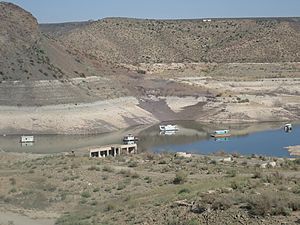McRae Formation facts for kids
Quick facts for kids McRae FormationStratigraphic range: Maastrichtian (Lancian) ~70–66Ma |
|
|---|---|

McRae Formation near its type location, Elephant Butte Reservoir, New Mexico, USA. The light bands are "bathtub rings" from stands of the reservoir.
|
|
| Type | Geological formation |
| Sub-units | Hall Lake & Jose Creek Members |
| Overlies | Mesaverde Group |
| Thickness | 3,000 ft (910 m) |
| Lithology | |
| Primary | Sandstone, shale, conglomerate |
| Other | Tuff |
| Location | |
| Coordinates | 33°11′49″N 107°10′01″W / 33.197°N 107.167°W |
| Approximate paleocoordinates | 40°24′N 85°42′W / 40.4°N 85.7°W |
| Region | New Mexico |
| Country | |
| Type section | |
| Named for | Fort McRae |
| Named by | Kelley & Silver |
| Year defined | 1952 |
The McRae Formation is a special layer of rocks found in southern New Mexico. These rocks formed a very long time ago, during the Late Cretaceous period. Scientists have found amazing fossils here, including parts of dinosaurs!
Contents
What is the McRae Formation?
This rock formation is made up of different kinds of rocks. At the bottom, there's a mix of conglomerate (rocks made of pebbles and bigger pieces stuck together) and shale (a soft, layered rock). Higher up, you'll find layers of sandstone (like hardened sand) and more shale.
The lower parts of the formation have pieces of volcanic rock. The upper parts have other kinds of rock fragments. The shales are reddish-brown or purplish, and the sandstones are light gray. Some of the sandstone layers are very thick and form hogbacks, which are steep, ridgelike hills.
The whole formation is over 914 meters (3,000 feet) thick! You can see it around the Elephant Butte Reservoir, in the Caballo Mountains, and under a large area called the Jornada del Muerto. It sits on top of an older rock layer called the Mesaverde Group.
The McRae Formation is split into two main parts: the lower Jose Creek Member and the upper Hall Lake Member. The Jose Creek Member seems to have formed from mudflows or alluvial fan deposits. This means mud and rocks flowed down hills in a warm, wet environment. It even has special breccia rocks, which are made of sharp, broken rock pieces.
Most of the McRae Formation is from the Late Cretaceous period, which ended about 66 million years ago. But some of the very top layers might be from the Paleocene epoch, which came right after.
Amazing Fossils Found Here
The McRae Formation is like a treasure chest of ancient life! Scientists have found many plant fossils, including types of ancient trees and plants that look like modern canna lilies and redwoods.
Dinosaur Discoveries
In 1905, a scientist named W.T. Lee found a skeleton of a ceratopsian dinosaur (like a Triceratops) in this area. Since then, more dinosaur pieces have been found in about twelve different spots. These include:
- Pieces of ceratopsian frills (the bony shield around their neck) and jawbones.
- Armor plates from ankylosaurs (tank-like dinosaurs).
- A leg bone (femur) from a giant, long-necked sauropod dinosaur.
- An incomplete jaw of a Tyrannosaurus rex! This famous fossil was found by someone on a boat in 1983.
Here are some of the dinosaurs whose remains have been identified:
- Tyrannosaurus rex
- Triceratops sp.
- Torosaurus sp.
- Alamosaurus sp.
How We Learned About the McRae Formation
The McRae Formation was first named in 1952 by two scientists, V.C. Kelley and Caswell Silver. They named it after Fort McRae. They said the best place to see these rocks was at the base of Elephant Butte and along the eastern shore of Elephant Butte Reservoir. Later, in 1955, another scientist named H.P. Bushnell divided the formation into its two members: Jose Creek and Hall Lake.
Scientists sometimes disagree about how to classify rock layers. In 1979, some researchers thought that rocks from another area, the Cub Mountain Formation, should actually be part of the McRae Formation. But other scientists, like Spencer G. Lucas, disagreed. They looked at the fossils and decided the Cub Mountain rocks were much younger.
In 2019, Lucas and his team suggested that the McRae Formation should be considered a "group" instead of just a "formation." A group is a bigger collection of rock layers. They also suggested adding a new top layer called the Double Canyon Formation. This new layer is over 425 meters (1,394 feet) thick and is found between Elephant Butte Reservoir and the Fra Cristobal Mountains.
See also


